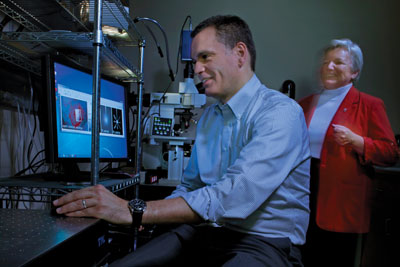
Dean Jeanette Roberts looks over the shoulder of Assistant Professor Robert Thorne, who sits at the microscopes used in his research. Unrestricted gifts to the Dean’s Priority Fund made possible the purchase of the specialized equipment. Photo by Steve Milanowski.
Robert Thorne has been looking for ways to cross the blood-brain barrier for the past 20 years. Thanks to donors who made unrestricted gifts, he has a powerful new tool to help illuminate the path.
Thorne joined the University of Wisconsin-Madison School of Pharmacy as assistant professor in the Pharmaceutical Sciences Division in June 2010. Dean Jeanette Roberts recruited the drug delivery specialist from the faculty of the New York University School of Medicine. She was able to purchase the microscope Thorne needed to advance his work using funds from the Dean’s Priority Fund.
“Gifts in this unrestricted fund vary in size from $5 to $1 million and allow me the flexibility to respond to new opportunities or challenges we face,” said Roberts. “Professor Thorne is doing cutting-edge research about drug delivery through the blood-brain barrier, which is a critical aspect of getting drugs to have targeted effects there. His contribution to the research enterprise of the School in this particular area is really extraordinary and did not exist before he came.”
Thorne was an undergraduate chemical engineering major when his father became ill with brain cancer. He learned about the unique physiology of the brain and how the structure limited treatment possibilities. In contrast to other organs that have large gaps in blood vessels allowing easy distribution of proteins or drugs—think liver or kidney—the brain has very tight spaces that do not allow for the same type of predictable diffusion. Although his father has passed away, Thorne’s interest in the blood-brain barrier continues, and his focus is developing an intranasal path for treatment of Alzheimer’s, Parkinson’s and other central nervous system disorders that attack neurons in the brain and lead to cell death.
Thorne is a founding member of the International Brain Barriers Society, an international scientific and educational nonprofit organization promoting scientific and clinical research on the biological barriers in the central nervous system. “We don’t really understand all we need to know to get predictable distribution (of a drug),” said Thorne. The goal is to find a way to allow the brain to receive the medication, biologic or other substance and diffuse it in a way that targets specific neurons and maintains a consistent concentration of the drug. It is a tall order, but Thorne notes it could have an enormous payoff as baby boomers come up against age-associated central nervous system diseases.
Thorne has customized the microscope for his research, making it one of only a handful in the world to do this type of work. “As you might imagine, the equipment necessary is quite specialized,” said Thorne. Dean Roberts recognized opportunity and challenge in drug delivery research and in adding to an outstanding pharmacy faculty. “Without that unrestricted money,” she said, “I would have never had the money to buy that piece of equipment and probably would have failed to recruit Professor Thorne.”
